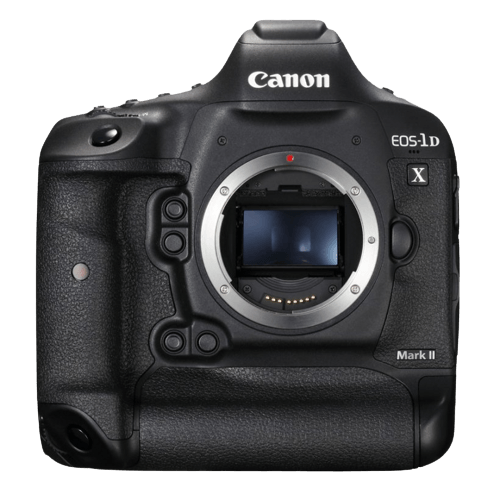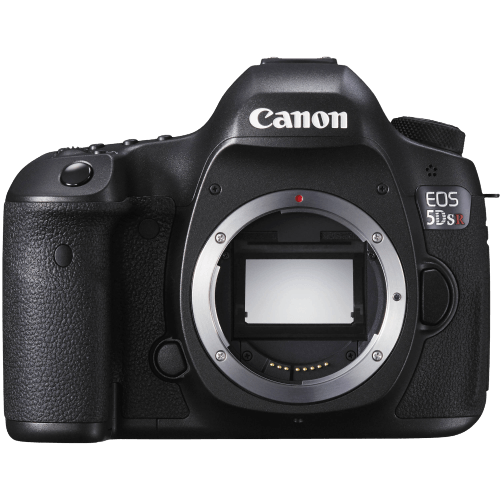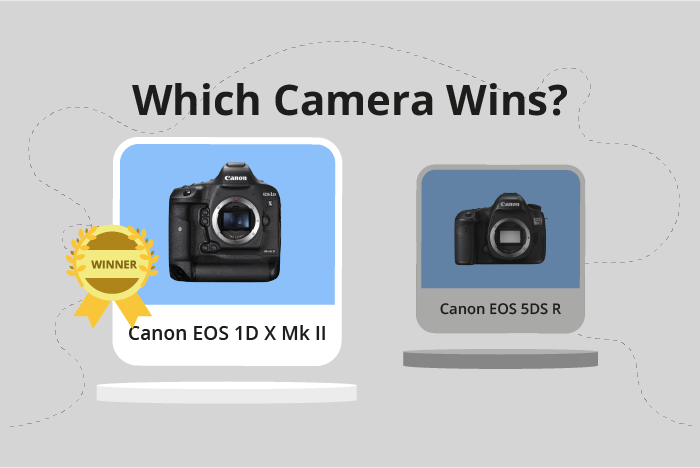Canon EOS 1D X Mark II vs EOS 5DS R Comparison
Canon EOS 1D X Mark II

Canon EOS 5DS R

The Canon EOS 1D X Mark II outperforms the Canon EOS 5DS R with a score of 73/100 compared to 68/100. Both cameras are DSLRs released by Canon, with the 1D X Mark II launching in 2016 and the 5DS R in 2015. They share some common specifications, such as camera type and manufacturer.
The 1D X Mark II excels with its larger size (158 x 168 x 83mm) and heavier weight (1530g / 3.37lbs), which provide better stability and durability. However, the 5DS R has its advantages as well, mainly in its lower launch price of $3900 compared to the 1D X Mark II’s $6000, and its lighter weight (930g / 2.05lbs), making it more portable and easier to handle.
Taking these factors into account, the Canon EOS 1D X Mark II’s higher score reflects its overall superiority, while the Canon EOS 5DS R offers a more budget-friendly and lightweight option for photographers.
Canon EOS 1D X Mark II vs EOS 5DS R Overview and Optics
The Canon EOS 5DS R wins in the optics comparison with a score of 73/100, while the Canon EOS 1D X Mark II scores 72/100. Both cameras share several specifications, including a CMOS sensor, full-frame sensor size, Canon EF lens mount, and no image stabilization.
The 5DS R’s advantage lies in its higher megapixel count of 50.6 compared to the 1D X Mark II’s 20.2 megapixels. This allows the 5DS R to capture more detail and offer higher resolution images, which is beneficial for large prints and cropping. However, the 1D X Mark II has a faster shooting speed of 16 frames per second, compared to the 5DS R’s 5 frames per second. This makes the 1D X Mark II better suited for action photography and capturing fast-moving subjects.
The 1D X Mark II also has a higher DXOMARK score for its sensor, scoring 88 compared to the 5DS R’s 86. This means the 1D X Mark II’s sensor performs slightly better in terms of overall image quality, dynamic range, and low-light performance. Additionally, the 1D X Mark II features a more advanced processor, the Dual Digic 6+, which contributes to its faster performance.
Despite the 5DS R’s higher score, both cameras excel in different areas. The 5DS R is better for high-resolution photography, while the 1D X Mark II is more suitable for action and fast-paced shooting situations. Ultimately, the choice between these two cameras depends on the specific needs and preferences of the photographer.
Canon EOS 1D X Mark II vs EOS 5DS R Video Performance
The Canon EOS 1D X Mark II outperforms the Canon EOS 5DS R in video capabilities, scoring 69/100 compared to the 5DS R’s 57/100. Both cameras share some common specifications, such as the ability to record video and having built-in microphone and headphone ports.
The 1D X Mark II’s higher score is due to its superior video resolution and frame rate. It can record 4K video at a maximum resolution of 4096 x 2160, while the 5DS R only reaches Full HD with a resolution of 1920 x 1080. The 1D X Mark II also has a higher maximum video frame rate of 60fps, double the 5DS R’s 30fps. These features allow the 1D X Mark II to capture more detailed and smoother footage.
On the other hand, the 5DS R has a notable advantage with its built-in time-lapse functionality, which the 1D X Mark II lacks. This feature enables users to create stunning time-lapse videos without the need for additional equipment or software.
Taking these factors into consideration, the Canon EOS 1D X Mark II is the clear winner in terms of video capabilities. Its 4K resolution and 60fps frame rate provide superior video quality compared to the 5DS R. However, the 5DS R’s time-lapse functionality may appeal to those who prioritize this feature in their video projects.
Canon EOS 1D X Mark II vs EOS 5DS R Features and Benefits
The Canon EOS 1D X Mark II outperforms the Canon EOS 5DS R with a feature score of 74/100 compared to the latter’s 59/100. Both cameras share certain specifications, such as a 3.2-inch screen size, and lack of WIFI and Bluetooth capabilities.
The 1D X Mark II boasts a higher screen resolution of 1,620,000 dots, as opposed to the 5DS R’s 1,040,000 dots. This difference provides the 1D X Mark II with a clearer and sharper display. Additionally, the 1D X Mark II has a touchscreen, while the 5DS R does not. The touchscreen allows for easier navigation and quicker adjustments to settings. Furthermore, the 1D X Mark II features GPS functionality, enabling users to geotag their photos, a feature absent in the 5DS R.
On the other hand, the 5DS R lacks any clear advantages over the 1D X Mark II in the features department. Both cameras have the same screen size and neither has WIFI or Bluetooth capabilities. The 5DS R’s lower screen resolution and absence of a touchscreen and GPS make it less competitive in this comparison.
The Canon EOS 1D X Mark II’s higher feature score, superior screen resolution, touchscreen, and GPS functionality make it the better choice between the two cameras. The Canon EOS 5DS R, while sharing some specifications with the 1D X Mark II, does not offer any advantages in terms of features.
Canon EOS 1D X Mark II vs EOS 5DS R Storage and Battery
The Canon EOS 1D X Mark II outperforms the Canon EOS 5DS R in storage and battery with a score of 79/100 compared to 65/100. Both cameras have two memory card slots, with the 1D X Mark II accepting Compact Flash and CFast 2.0 cards, while the 5DS R takes SD/SDHC/SDXC (UHS-I compatible) and Compact Flash cards. Neither camera offers USB charging.
The 1D X Mark II excels with its battery life, providing 1210 shots per charge using the LP-E19 battery. In contrast, the 5DS R delivers 700 shots per charge with its LP-E6 battery. This significant difference in battery life makes the 1D X Mark II more reliable for extended shooting sessions.
The 5DS R has no clear advantages in storage and battery performance, as it shares similar memory card capabilities but falls short in battery life. In this comparison, the Canon EOS 1D X Mark II proves to be the superior choice for photographers seeking better storage and battery performance.
Canon EOS 1D X Mark II vs EOS 5DS R – Our Verdict
Are you still undecided about which camera is right for you? Have a look at these popular comparisons that feature the Canon EOS 1D X Mark II or the Canon EOS 5DS R:

